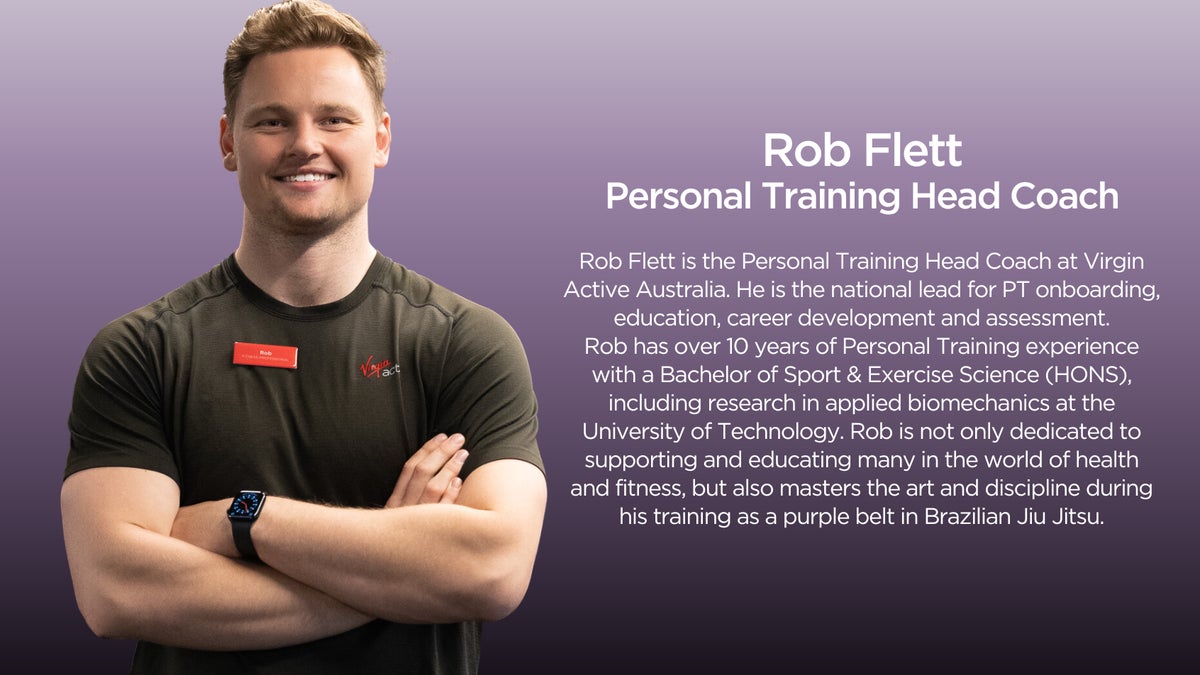No pain, no gain. 5 myths about muscle soreness
by Rob Flett on Sunday 03 September 2023
4 min read
Have you ever woken up with sore, achy muscles? The type of pain that has you reflecting on the day before. Novelty is the primary reason for experiencing soreness. If you do something out of the ordinary, that is physically demanding, you’ll likely be sore the next day.
Here we will explore some common myths around muscle soreness as it relates to fitness.
Firstly – what is exercise induced muscle soreness?
Strenuous, unaccustomed physical effort induces significant amounts of muscle damage – a disruption (or microtrauma) to the muscle fibres, leading to soreness. This sparks an inflammatory response where immune cells are shunted to repair tissues(1).
Have you ever wondered why muscle soreness continues to get worse days after a tough bout of activity?
This inflammatory response is the reason. It causes secondary muscle damage, leading to a widely referenced condition called “delayed onset muscle soreness” (DOMS).
Myth 1: “Soreness is the start of muscle growth”
Although it correlates with muscle growth, soreness is not causative. Muscle growth is linked to progressively increasing exposure to mechanical tension (external load) over time. Despite occasional soreness being a likely byproduct, it should not be the objective. Excessive soreness leads to unnecessary reductions in training frequency, thereby reducing capacity to optimise mechanical tension(2,3).
Put simply, aim to make muscles stronger in the long term rather than sore in the short term.
Myth 2: “the fitter you are, the less likely you’ll be sore”
Even the most seasoned gym-goers are at risk of debilitating soreness if unaccustomed. By example, a powerlifter doing an impromptu high-intensity cycle class, will likely be sore the next day. The new movement demand, muscle contraction type and energy system utilisation will cause muscle damage and metabolite build-up of which they are not conditioned to deal with(4).
This speaks to the importance of being sensible when embarking on a new fitness journey. Know how to give a conservative effort and gradually increase your training load over time.
Myth 3: “the more soreness, the more effective a workout”
Rather, the more muscle damage. In extreme cases, catastrophic muscle damage can cause myoglobin proteins to leak into the bloodstream, leading to a critical condition known as Rhabdomyolysis(5). At the very least, debilitating soreness directly opposes fitness gains as the downtime needed to recover will lead to overall suboptimal training(3).
Myth 4: “you should never be sore”
It’s important to remember that muscle soreness occurs on a spectrum and that If you’re never sore, you might be under-doing it.
A good rule of thumb is the stretch test. The day after a hard workout, simply place the muscles you used through a gentle stretch. If you feel a bit of soreness at full stretch, you’re likely training hard enough(4). On the other hand, if you can barely walk or straighten your arms, you likely need to rethink your approach.
Myth 5: “you can’t reduce muscle soreness”
Sometimes life just happens. Your friend needs help moving, or you’re needed to make up the numbers in a friendly soccer match. Now you know you’ll likely be experiencing a degree of muscle damage you’re unaccustomed to, here are some tips to reduce the subsequent pain.
- Foam rolling or any myofascial release/massage.
- Adequate protein intake
- Warm-up/cool-down
- General activity post-event
- Hot cold/therapy
All these strategies can help reduce the severity of pain in the days following(6,7,8). However, please note an intelligent training approach is always the best prevention.
If you need support with your training, our experienced Personal Trainers are committed to helping you achieve your fitness goals safely and effectively. If you found this article helpful in dispelling the misconceptions surrounding muscle soreness, imagine the benefits of having a dedicated trainer by your side! Don't hesitate to reach out to us and take the next step toward a healthier, stronger you!
About the author
Citations
- Owens DJ, Twist C, Cobley JN, Howatson G, Close GL. (2019) Exercise-induced muscle damage: What is it, what causes it and what are the nutritional solutions? Eur J Sport Sci.
- Krzysztofik M, Wilk M, Wojdała G, Gołaś A. (2019) Maximizing Muscle Hypertrophy: A Systematic Review of Advanced Resistance Training Techniques and Methods. Int J Environ Res Public Health.
- Grgic J, Schoenfeld BJ, Davies TB, Lazinica B, Krieger JW, Pedisic Z. (2018) Effect of Resistance Training Frequency on Gains in Muscular Strength: A Systematic Review and Meta-Analysis. Sports Med.
- Lopes, T.R.; Pereira, H.M.; Silva, B.M. (2021) Perceived Exertion: Revisiting the History and Updating the Neurophysiology and the Practical Applications. Int. J. Environ. Res. Public Health
- Torres PA, Helmstetter JA, Kaye AM, Kaye AD. (2015) Rhabdomyolysis: pathogenesis, diagnosis, and treatment. Ochsner J.
- Dupuy O, Douzi W, Theurot D, Bosquet L, Dugué B. (2018) An Evidence-Based Approach for Choosing Post-exercise Recovery Techniques to Reduce Markers of Muscle Damage, Soreness, Fatigue, and Inflammation: A Systematic Review With Meta-Analysis. Front Physiol.
- Wang Y, Li S, Zhang Y, Chen Y, Yan F, Han L, Ma Y. (2021) Heat and cold therapy reduce pain in patients with delayed onset muscle soreness: A systematic review and meta-analysis of 32 randomized controlled trials. Phys Ther Sport.
- Tanabe, Y.; Fujii, N.; Suzuki, K. (2022) Dietary Supplementation for Attenuating Exercise-Induced Muscle Damage and Delayed-Onset Muscle Soreness in Humans. Nutrients.
Related articles
Unwind
3 min read
Are you experiencing mental or physical fatigue?
Unwind
3 min read
How to manage holiday stress and anxiety
Unwind
3 min read
Sleep vitamins (that actually work)
Enjoying our blog?
Sign up to our newsletter to get updates on training, healthy living, news and events.







